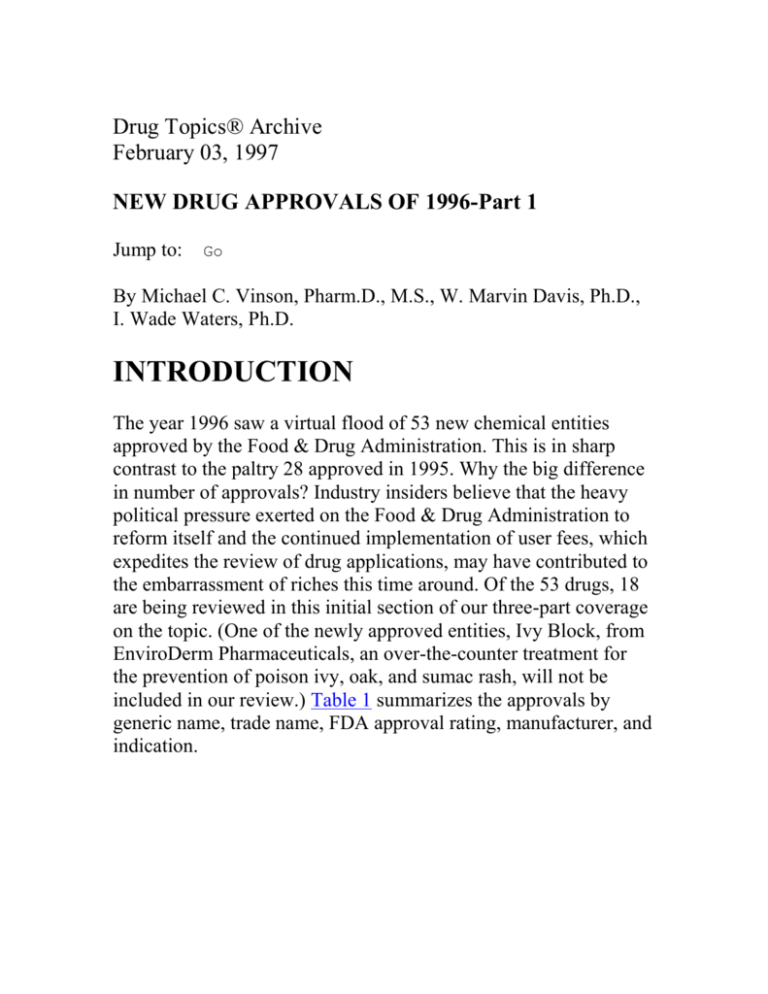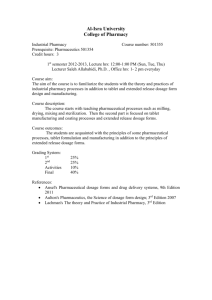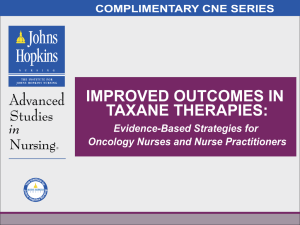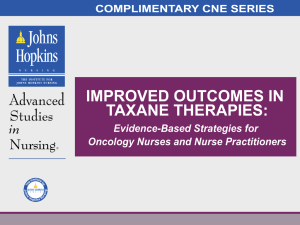
Drug Topics® Archive
February 03, 1997
NEW DRUG APPROVALS OF 1996-Part 1
Jump to:
Go
By Michael C. Vinson, Pharm.D., M.S., W. Marvin Davis, Ph.D.,
I. Wade Waters, Ph.D.
INTRODUCTION
The year 1996 saw a virtual flood of 53 new chemical entities
approved by the Food & Drug Administration. This is in sharp
contrast to the paltry 28 approved in 1995. Why the big difference
in number of approvals? Industry insiders believe that the heavy
political pressure exerted on the Food & Drug Administration to
reform itself and the continued implementation of user fees, which
expedites the review of drug applications, may have contributed to
the embarrassment of riches this time around. Of the 53 drugs, 18
are being reviewed in this initial section of our three-part coverage
on the topic. (One of the newly approved entities, Ivy Block, from
EnviroDerm Pharmaceuticals, an over-the-counter treatment for
the prevention of poison ivy, oak, and sumac rash, will not be
included in our review.) Table 1 summarizes the approvals by
generic name, trade name, FDA approval rating, manufacturer, and
indication.
DOCETAXEL (Rhône-Poulenc Rorer)
Taxotere
A semisynthetic analog of paclitaxel, docetaxel is produced from a
precursor obtained from renewable biomass (needles) of plants in
the yew group. Much like paclitaxel, it acts as an antineoplastic via
inhibition of the microtubule functions in cells preparing for
mitosis. Docetaxel is highly lipophilic and practically insoluble in
water. Thus, it is supplied as a concentrate in a nonaqueous
solution that must be mixed with an aqueous diluent, which
contains polysorbate 80, to prepare a solution for intravenous
infusion.
Indications: Doctaxel is FDA-approved for palliative therapy and
extending survival time, especially for patients whose locally
advanced or metastatic breast cancer has progressed in spite of
anthracycline-based chemotherapy. It is also recommended for
ovarian or small-cell lung cancer; however, this is not an FDAapproved indication.
Pharmacology: Docetaxel binds to free tubulin, favoring its
assembly into microtubules, but then inhibits the disassemblydepolymerization-that is necessary for microtubule function in
mitosis. Stabilization of tubules is thus the mechanism by which
both paclitaxel and docetaxel prevent cell proliferation. However,
there is evidence that the two do not act in a completely identical
manner. For example, docetaxel is effective in vitro against tumor
cells that are resistant to paclitaxel.
Contraindications: Docetaxel should not be used in patients with
neutropenia whose neutrophil counts are less than 1500 cells/mm3
or in those with a history of severe hypersensitivity to docetaxel or
paclitaxel or other agents formulated with polysorbate 80. It should
not be used in case of pregnancy or acute infection.
Precautions: Docetaxel should be administered only under the
supervision of a physician experienced in the use of antineoplastic
agents. Adequate diagnostic and treatment facilities for
management of therapeutic complications are a prerequisite for
proper use of docetaxel. There is no antidote known for a toxic
overdose of docetaxel, which may cause bone marrow suppression,
neurotoxicity, and/or mucositis.
"Toxic deaths," largely from sepsis, for which docetaxel was
judged responsible or contributory, have occurred at a rate of about
2% in patients having normal liver function and about 11% in
patients with abnormal hepatic function measures. A much lower
mortality rate was seen with a 60 mg/m2 dosage. One patient each
who received unintended doses of 150 and 200 mg/m2 of docetaxel
recovered without incident despite severe neutropenia and other
milder reactions. Thus, there is cause for caution in cases of liver
disease/dysfunction as well as congestive heart failure, bone
marrow suppression, or bone marrow transplant. There is a high
likelihood for teratogenesis or embryotoxicity if taken by a
pregnant woman.
Drug interactions: As with other antineoplastic agents, docetaxel
may interact with amphotericin B (including the lipid complex
form) to increase the risk for nephrotoxicity, hypotension, and
bronchospasm. If it is necessary to give the two medications
together, blood pressure, renal function, and pulmonary function
should be monitored.
Docetaxel has been reported to exhibit synergism with 5fluorouracil, cyclophosphamide, and etoposide and also appears to
possess radiation-sensitizing effects.
Since the medication is metabolized by the cytochrome P-450
system (3A isozyme), agents that induce, inhibit, or are
metabolized by this system may interact with it. Examples of such
medications include cyclosporine, terfenadine, ketoconazole,
erythromycin, and troleandomycin. Caution should be exercised
when administering docetaxel in patients taking any of these drugs.
Adverse reactions: Bone marrow suppression is the most
frequently occurring and the major dose-limiting toxicity of
docetaxel. The neutropenia that occurs in about 96% of patients is
reversible and not cumulative. Bleeding episodes due to
thrombocytopenia have been reported in about 2% of patients, and
fatal GI bleeding has occurred. Anemia has occurred at a rate of
almost 90%, though it was deemed severe in about 8% of patients
in clinical trials.
Fluid retention has been described in patients receiving docetaxel.
It may be manifested as edema and weight gain, pleural effusion,
pericardial effusion, or ascites, though the latter three occur less
frequently. This fluid retention was deemed severe in 6% of
patients in clinical trials, and treatment had to be discontinued as a
result in 1.7%. The side effect is cumulative in incidence and
severity but is completely reversible when therapy is discontinued,
usually resolving after about 29 weeks (range of 0 to 42 + weeks).
Dosage: The recommended dosage of docetaxel is 60 to 100
mg/m2 infused intravenously over one hour and repeated every
three weeks. Oral premedication with a corticosteroid such as
dexamethasone (starting one day prior to therapy), along with an
intravenous dose of diphenhydramine (50 mg, 30 min. prior), is
required to reduce the incidence and severity of hypersensitivity
reactions and fluid retention. If febrile neutropenia, severe
cutaneous reactions, or severe peripheral neuropathy occur and
persist after a 100 mg/m2 dosage, patients should have dose
reduction to 75 or even to 55 mg/m2. When started at 60 mg
without severe adverse effects, the dosage may be increased to a
patient's tolerance level. (See "Precautions" above regarding
toxicity.) Dosage adjustment is not required for elderly patients if
no hepatic deficit exists. For patients younger than 16 years,
efficacy and safety have not been established.
Taxotere is available as a concentrate in single-dose vials. There
are 20-mg and 80-mg strengths, each packaged with its diluent
(13% ethanol in Water for Injection) in a blister pack. The product
should be refrigerated and protected from bright light. When
premixed, each package produces a concentration of 10 mg/mL,
which is then further diluted before using.
Patient counseling: Patients should be mindful of the possible
adverse effects involving the skin (eruptions, urticaria, alopecia),
GI tract (nausea, vomiting, diarrhea, stomatitis, or mucositis), and
nervous system (paresthesias, numbness, weakness), but especially
of dyspnea, which may indicate a pleural effusion urgently
requiring fluid drainage to maintain adequate respiration.
Michael C. Vinson, Pharm.D., M.S.
Associate Professor Department of Clinical Pharmacy Practice, Research
Institute of Pharmaceutical Sciences University of Mississippi, School of
Pharmacy
W. Marvin Davis, Ph.D.
Professor, Department of Pharmacology, Research Institute of
Pharmaceutical Sciences University of Mississippi, School of Pharmacy
I. Wade Waters, Ph.D.
Professor, Department of Pharmacology, Research Institute of
Pharmaceutical Sciences University of Mississippi, School of Pharmacy
Copyright © 1997 and published by Medical Economics Company
at Montvale, NJ 07645-1742. All rights
reserved.ore/content/journals/d/data/1997/0203/thumb/d2a06610.th
b">
Click here to view full-size graphic
Michael C. Vinson, Pharm.D., M.S.
Associate Professor Department of Clinical Pharmacy Practice, Research
Institute of Pharmaceutical Sciences University of Mississippi, School of
Pharmacy
W. Marvin Davis, Ph.D.
Professor, Department of Pharmacology, Research Institute of
Pharmaceutical Sciences University of Mississippi, School of Pharmacy
I. Wade Waters, Ph.D.
Professor, Department of Pharmacology, Research Institute of
Pharmaceutical Sciences University of Mississippi, School of Pharmacy
Copyright © 1997 and published by Medical Economics Company
at Montvale, NJ 07645-1742. All rights reserved.







